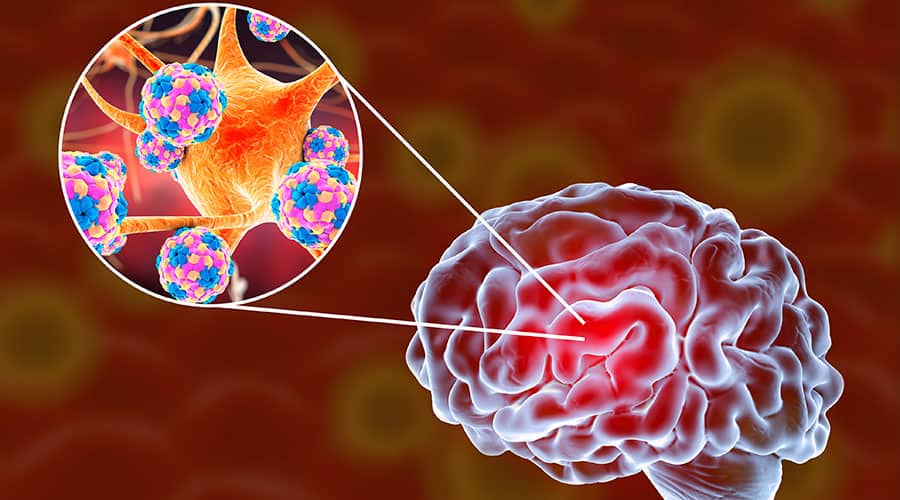
With this new column, Elite will compile an index of various infectious diseases, occasionally highlighting emerging conditions.
Encephalitis
General definition and information: An inflammation of the brain that is most commonly caused by a viral infection, but may be caused by other factors as well, such as bacterial infections and noninfectious inflammatory conditions. The condition often causes only mild flu-like signs and symptoms — such as a fever or headache — or no symptoms at all, according to the Mayo Clinic. More severe symptoms can occur and the condition can also cause confused thinking, seizures, or problems with senses or movement. Rarely, a life-threatening illness, the condition does require timely diagnosis and treatment due to the difficulty in being able to predict how each individual person will be affected by the condition.
According to the Mayo Clinic, there are two main types of encephalitis:
- Primary encephalitis: Occurs when a virus or other agent directly infects the brain. The infection may be concentrated in one area or widespread. A primary infection may be a reactivation of a virus that had been inactive after a previous illness.
- Secondary encephalitis: Results from a faulty immune system reaction to an infection elsewhere in the body. Instead of attacking only the cells causing the infection, the immune system also mistakenly attacks healthy cells in the brain. Also known as post-infection encephalitis, secondary encephalitis often occurs 2-3 weeks after the initial infection.
Causes & Modes of Transmission: The viruses that can cause encephalitis include herpes simplex virus and other herpes viruses, enteroviruses, mosquito-borne viruses, tick-borne viruses, the rabies virus, and common childhood infections, including measles (rubeola), mumps, and German measles (rubella). According to the Mayo Clinic, these causes are now rare in the United States due to the availability of vaccinations.
Treatment Strategies: Diagnosis of encephalitis could require any combination of physical exam, brain imaging, spinal tap, lab tests, electroencephalogram, and brain biopsy. According to the Mayo Clinic, treatment for mild symptoms typically includes bed rest, fluids, and anti-inflammatory drugs. If antiviral drugs are needed, common prescriptions include acyclovir, ganciclovir, and foscarnet, according to the Mayo Clinic.
Supportive care and follow-up therapy could be necessary for patients who are hospitalized with severe symptoms and could include breathing assistance, heart function monitoring, intravenous fluids, and anticonvulsant medications. Physical therapy, occupational therapy, speech therapy, and psychotherapy could also be necessary to develop everyday skills and to use adaptive products that help with everyday activities. Speech therapy can help to relearn muscle control and coordination to produce speech, and psychotherapy can assist with learning to cope and practice new behavioral skills that assist in improving mood disorders and/or address personality changes.
Prevention Parameters: According to the Mayo Clinic, the best way to prevent viral encephalitis is to take precautions to avoid exposure to viruses that can cause the disease. Healthcare providers should encourage patients to: practice good hygiene and hand washing; avoid sharing utensils, tableware, and beverages; teach children good habits in the home and at school, and to receive vaccinations (and follow through with appropriate vaccines for children). Additionally, patients who may be traveling should be educated on recommended vaccinations for different destinations.
Taking protection against mosquitoes and ticks can also minimize risks, according to the Mayo Clinic. Patients should be informed to avoid mosquitoes and dress in long-sleeved shirts/long pants when outside between dusk and dawn during mosquito activity and when in wooded areas with tall grasses and shrubs, where ticks are more common; apply mosquito repellent to both the skin and clothes (following specific brand directions for safety measures); use insecticide (products containing permethrin, which repels and kills ticks and mosquitoes, can be sprayed on clothing, tents, and other outdoor gear, according to the Environmental Protection agency); eliminate water sources outside one’s home, where mosquitoes can lay their eggs; and look for outdoor signs of viral disease (dying birds or other animals) and report any observations to the local health department.
For purposes of protecting young children, patients should be advised that insect repellents aren’t recommended for use on infants who are younger than 2 months of age and that, alternatively, infant carriers or strollers can be covered with mosquito netting. For older infants and children, repellents with 10-30 percent DEET are considered safe, according to the Mayo Clinic.





